The Current State of the Engineering Method for the Optimal Gas-Dynamic Design and Calculation of Centrifugal Compressor
Abstract
:1. Introduction
2. Materials and Methods: Fundamentals of the Physical and Mathematical Models
- Coriolis forces prevent flow separation on hub and shroud surfaces and on the impeller blades’ pressure side at all flow rates;
- On the impeller blades’ suction side, the flow according to the “jet-wake” scheme takes place at all flow rate regimes in most impellers;
- Flow separation in the vane diffusers takes place on the vane pressure side in all flow regimes;
- The velocity diagrams of an inviscid quasi-three-dimensional flow calculated by the method of integral equations in the non-incidence flow regime are close to the measured velocity diagrams. These are the valuable source of information about the flow behavior and the impeller loading factor. Figure 3 presents the results of measurement and calculation of the velocity diagrams of two 2-D impellers with radial cylindrical blades;
- A decrease in efficiency with an increase in Mach numbers is most dependent on the value of the maximum local Mach number on the impeller blades;
- The dependence of the loading factor versus the flow coefficient at the impeller outlet is linear.
3. Results
3.1. The Application of CFD Calculations in Mathematical Modeling
3.2. Loss Model Identification
3.3. Compressor Candidate’s Comparison. New Version of the Simplified Efficiency Model
- The shafts’ number;
- The shafts rpm;
- The stages’ number on the shafts;
- Impellers’ diameters;
- The number of intermediate cooling;
- Impellers’ types (2-D radial or 3-D axial);
- Diffusers’ types (VD, VLD).
3.4. Preliminary Design
- The diagram of velocity should have a favorable character. This means a controlled value of the maximum speed on the blade, a low deceleration on the suction side, and a favorable blade’s load;
- Inlet blade angles should provide a non-incidence flow inlet;
- The ratio of the calculated to non-viscid flow loading factors should be 0.93.
4. Discussion
4.1. Optimal Compressor Design. Example No. 1
4.2. Optimal Compressor Design. Example No. 2
5. Conclusions
Author Contributions
Funding
Conflicts of Interest
References
- Galiullin, Z.T.; Salnikov, S.Y.; Shchurovsky, V.A. Modern Gas Transmission Systems and Technologies; Gazprom VNIIGAZ: Moscow, Russia, 2014; p. 345. [Google Scholar]
- Seleznev, K.P. Centrifugal Compressors. [text]/K.P. Seleznev. Yu.B. Galerkin//; Publishing House Mechanical Engineering, Leningrad Department: Leningrad, Russia, 1982. [Google Scholar]
- PCA Engineers Limited. Available online: http://www.pcaeng.co.uk/software (accessed on 27 June 2019).
- Japikse, D. Agile engineering and the restructuring of modern design. In Proceedings of the 40th Israel Annual Conference on Aerospace Science, Tel-Aviv and Haifa, Israel, 23–24 February 2000. [Google Scholar]
- Qiu, X.; Japikse, D.; Zhao, J.; Anderson, M.R. Analysis and Validation of a Unified Slip Factor Model for Impellers at Design and Off-Design Conditions. J. Turbomach. 2011, 133, 041018. [Google Scholar] [CrossRef]
- Drozdov, A.V. The use of identification methods and multi-mode optimization in the design of centrifugal compressors. In Proceedings of the 19th International Symposium “Consumers-Manufacturers of Compressors and Compressor Equipment”, SPb, Russia, 17–19 June 2015; pp. 69–73. [Google Scholar]
- Lunev, A.T. Development of highly efficient replaceable flowing paths of pipeline centrifugal compressors. Dis. Tech. Sci. 2005, 123. [Google Scholar]
- Borovkov, A.I.; Voinov, I.B.; Galerkin, Y.B.; Nikiforov, A.G.; Nikitin, M.A. Issues of Modeling Gas-Dynamic Characteristics on The Example of a Model Stage of a Centrifugal Compressor. Scientific and Technical Statements; SPbPU: St. Petersburg, Russia, 2018; pp. 44–57. [Google Scholar]
- Borovkov, A.I.; Voinov, I.B.; Rekstin, A.F.; Bakaev, B.V. Modeling the Characteristics of a Two-Stage Pipeline Centrifugal Compressor. Scientific and Technical Statements; SPbPU: St. Petersburg, Russia, 2019; pp. 87–104. [Google Scholar]
- Borovkov, A.I.; Voinov, I.B.; Nikitin, M.A.; Galerkin, Y.B.; Rekstin, A.F.; Drozdov, A.A. Modeling the characteristics of a single-stage pipeline centrifugal compressor. Nat. Engin. Sci. 2018, 24, 153–175. [Google Scholar] [CrossRef]
- Nikiforov, A.; Popova, D.; Soldatova, K. A network application for modeling a centrifugal compressor performance map. In Proceedings of the IOP Conference Series: Materials Science and Engineering, Bristol, UK, 11–13 September 2017; IOP Publishing: Bristol, UK, 2017; Volume 232, p. 12046. [Google Scholar]
- Kortikov, N.; Borovkov, A.; Voynov, I.; Kirillov, A.; Drozdov, A. Erratum to: Simulation of the joint effect of rotor-stator interaction and circumferential temperature unevenness on losses in the turbine stage. In Proceedings of the MATEC Web of Conferences; EDP Sciences: SPb, Russia, 5 December 2018; Volume 245, p. 04019. [Google Scholar]
- Babák, M. Effective Computational Procedure for High Pressure Ratio Centrifugal Compressor; TechSoft Engineering: Berlin, Germany, 2009. [Google Scholar]
- Prasad, V.V. Centrifugal compressor fluid flow analysis using CFD. Sci. Insights Internat. J. 2011, 1, 6–10. [Google Scholar]
- Guidotti, E. Towards Centrifugal Compressor Stages Virtual Testing. Ph.D. Thesis, Università degli Studi di Bologna, Bologna, Spain, 2014; p. 100. [Google Scholar]
- Mosdzien, M.; Enneking, M.; Hehn, A.; Grates, D.; Jeschke, P. Influence of blade geometry on secondary flow development in a transonic centrifugal compressor. J. Global Power Prop. Soc. 2018, 2. [Google Scholar] [CrossRef]
- Sorokes, J.M. Sidestream optimization through the use of computational fluid dynamics and model testing. Turbomach. Symp. 2000. [Google Scholar] [CrossRef]
- Hehn, A.; Mosdzien, M.; Grates, D.; Jeschke, P. Aerodynamic optimization of a transonic centrifugal compressor by using arbitrary blade surfaces. J. Turbomachin. 2018, 140, 051011. [Google Scholar] [CrossRef]
- Marenina, L.N. CFD modeling and analysis of the characteristics of the stator elements of the centrifugal compressor stage flow path. Comp. Techn. Pneum. 2016, 3, 27–35. [Google Scholar]
- Rekstin, A.F.; Drozdov, A.A.; Solovyeva, O.A.; Galerkin, Y.B. Two mathematical models centrifugal compressor stage vaneless diffuser comparison. In Proceedings of the AIP Conference Proceedings, Omsk, Russia, 26 February–2 March 2018; Volume 2007, p. 030035. [Google Scholar] [CrossRef]
- Galerkin, Y.B. The development of the scientific school of turbocompressor engineering LPI-SPbPU Peter the Great. In Proceedings of the International Scientific and Technical Conference, Kazan, Russia, 23–24 May 2017; pp. 19–29. [Google Scholar]
- Drozdov, A.A. Design Method for Centrifugal Compressors With 3D Impellers; SPbPU: St. Petersburg, Russia, 2016; p. 236. [Google Scholar]
- Proceedings of the Scientific School of Compressor Engineering SPbSTU. [Text]; Yu, B.G. (Ed.) Publishing House AOOT “NPO CKTI”: Saint-Petersburg, Russia, 2000. [Google Scholar]
- Galerkin, Y.B. Modeling the Workflow of Industrial Centrifugal Compressors. Scientific Foundations, Stages of Development, Current Status; Monograph, SPbPU: St. Petersburg, Russia, 2011; p. 327. [Google Scholar]
- Galerkin, Y.B. Turbocompressors. Workflow, Calculation and Design of The Flow Path; KHT: Gelsenkirchen, Germany, 2010. [Google Scholar]
- Galerkin, Y.; Drozdov, A. New generation of universal modeling for centrifugal compressors calculation. In Proceedings of the IOP Conference Series: Materials Science and Engineering, London, UK, 7–9 September 2015; IOP Publishing: London, UK, 2015; Volume 90, p. 012040. [Google Scholar]
- Galerkin, Y.; Soldatova, K. Universal modeling method application for development of centrifugal compressor model stages. In Proceedings of the International Conference on Compressors and their Systems, London, UK, 9–10 September 2013; pp. 477–487. [Google Scholar]
- Lysyakova, A.A. Improving Programs for Calculating the Characteristics of Centrifugal Compressor Stages Using Generalized Flow Velocity Diagrams of Blades; SPbSPU: St. Petersburg, Russia, 2010; p. 141. [Google Scholar]
- Soldatova, K.V. Creation of A New Mathematical Model of The Centrifugal Compressors Flow Path and A Database of Model Stages; SPbSPU: St. Petersburg, Russia, 2017; p. 357. [Google Scholar]
- Galerkin, Y.; Drozdov, A.; Soldatova, K. Centrifugal compressor efficiency types and rational application. In Proceedings of the 8th International Conference on Compressors and their Systems, London, UK, 9–10 September 2013; pp. 533–542. [Google Scholar]
- Seleznev, K.P.; Galеrkin, Y.B. Mathematical Modelling of Performance Characteristics and Optimization of Turbomachine Stades. In Proceedings of the International Gas Turbine Congress, Tokyo, Japan, 23–29 October 1983. [Google Scholar]
- Galerkin, Y.; Rekstin, A.; Soldatova, K.; Drozdov, A. Universal Modeling Method: The Instrument for Centrifugal Compressor Gas Dynamic Design. In Proceedings of the ASME 2015 Gas Turbine India Conference, Hyderabad, India, 2–3 December 2015. [Google Scholar]
- Vasiliev, Y.S. New generation high performance centrifugal compressors. Scientific principles of calculation, development of optimal design methods and production development. Sci. Ind. Russia 2000, 10, 78–85. [Google Scholar]
- Solovyova, O.A. A Mathematical Model for Calculating the Gas-Dynamic Characteristics and Optimizing the Vaneless Diffusers of Centrifugal Compressor Stages; SPbPU: St. Petersburg, Russia, 2018; p. 162. [Google Scholar]
- Popova, E.Y. Optimization of The Main Parameters of Stages of Turbomachines Based on Mathematical Modeling; SPbSPU: St. Petersburg, Russia, 1991. [Google Scholar]
- Rekstin, A.; Popova, Y.; Ucehovscy, A. Centrifugal compressor stages efficiency analysis by means of the approximate algebraic equations. In Proceedings of the AIP Conference Proceedings, Omsk, Russia, 26 February–2 March 2018; Volume 2007, p. 030036. [Google Scholar] [CrossRef]
- Den, G.N. Design of the Flow Path of Centrifugal Compressors; Leningrad Branch: Moscow, Russia, 1980; p. 230. [Google Scholar]
- Riess, V.F. Centrifugal Compressor Machines; Leningrad Branch: Moscow, Russia, 1981; p. 351. [Google Scholar]
- Khisameev, I.G. Design and Operation of Industrial Centrifugal Compressors; FEN Publishing House: Kazan, Russia, 2012. [Google Scholar]
- Shnepp, V.B. Design and Calculation of Centrifugal Compressor Machines; Publishing house, Mechanical Engineering: Moscow, Russia, 1995; p. 240. ISBN 5-217-01196-3. [Google Scholar]
- Aungier, R.H. Centrifugal Compressors: A Stragedy For Aerodynamic Design and Analysis; ASME Press: New York, NY, USA, 2000; p. 320. [Google Scholar]
- Cumpsty, N.A. Compressor Aerodynamics; Longman Scientific and Technical: London, UK, 1989. [Google Scholar]
- Japikse, D. Effective two-zone modeling of diffusers and return channel systems for radial and mixed-flow pumps and compressors. In Proceedings of the 11th International Symposium on Transport Phenomena and Dynamics of Rotating Machinery, Honolulu, HI, USA, 26 February–2 March 2006. [Google Scholar]
- Drozdov, A.A.; Rekstin, A.F. Analysis of the Velocity Charts of the Impellers of Centrifugal Compressor Stages After the Preliminary Design; SPbPU: St. Petersburg, Russia, 2019; pp. 79–91. [Google Scholar]
- Galerkin, Y.B. Design issues for the flow of centrifugal compressors of natural gas. Compressor Engineering and Pneumatics in the 21st Century. In Proceedings of the International Scientific and Technical Conference on Compressor Engineering, Sumy, Ukraine, 15–17 September 2004; pp. 166–188. [Google Scholar]
- Rekstin, A.F.; Bakaev, B.V. Variant Calculations of Industrial Centrifugal Compressors Based on A Simplified Mathematical Model; SPbPU: St. Petersburg, Russia, 2018; pp. 24–38. [Google Scholar]
- Galerkin, Y.B.; Rekstin, A.F.; Drozdov, A.A.; Kaminsky, R.V.; Sibiryakov, S.V.; Turgenev, T.I.; Usenko, A.E. Experience in creating a low-pressure turbocharger for boosting internal combustion engine using the modern version of the Universal Modeling Method. Compres. Techn. Pneum. 2019, 2, 2–10. [Google Scholar]
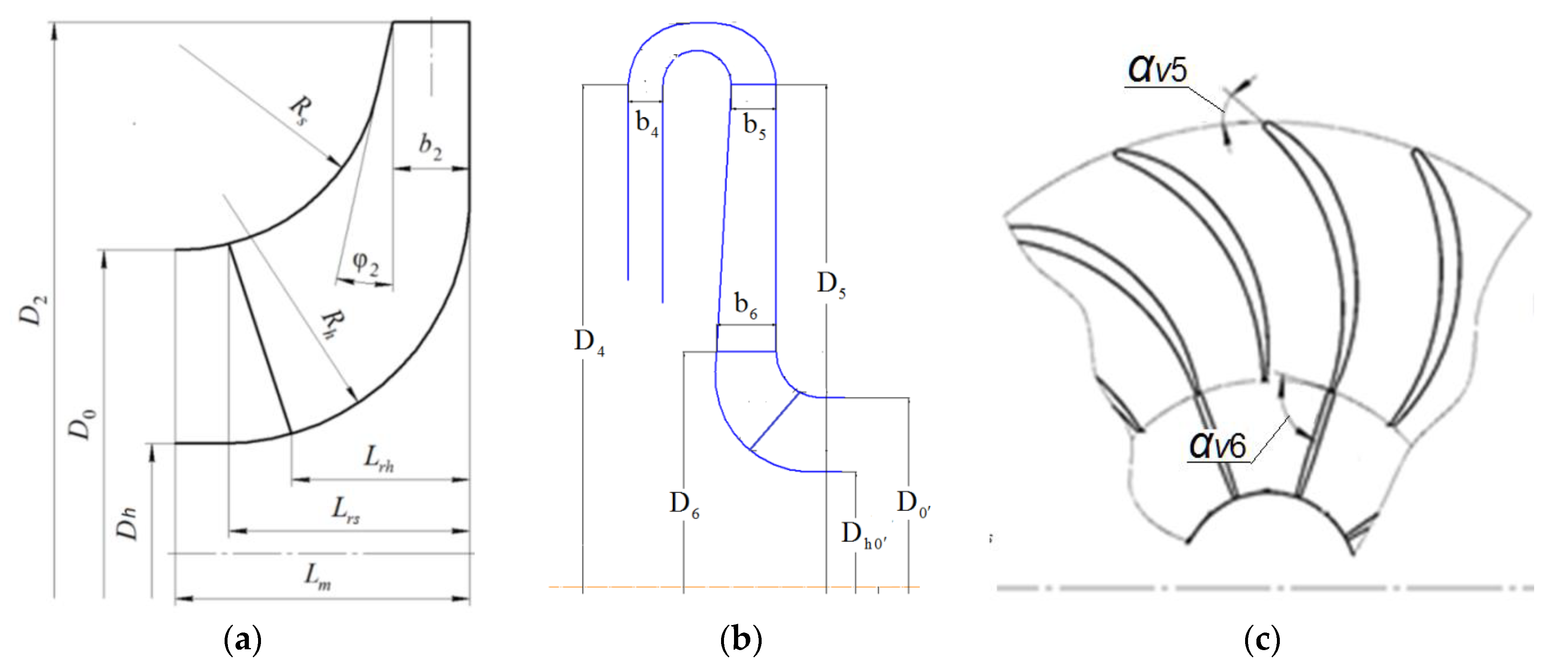
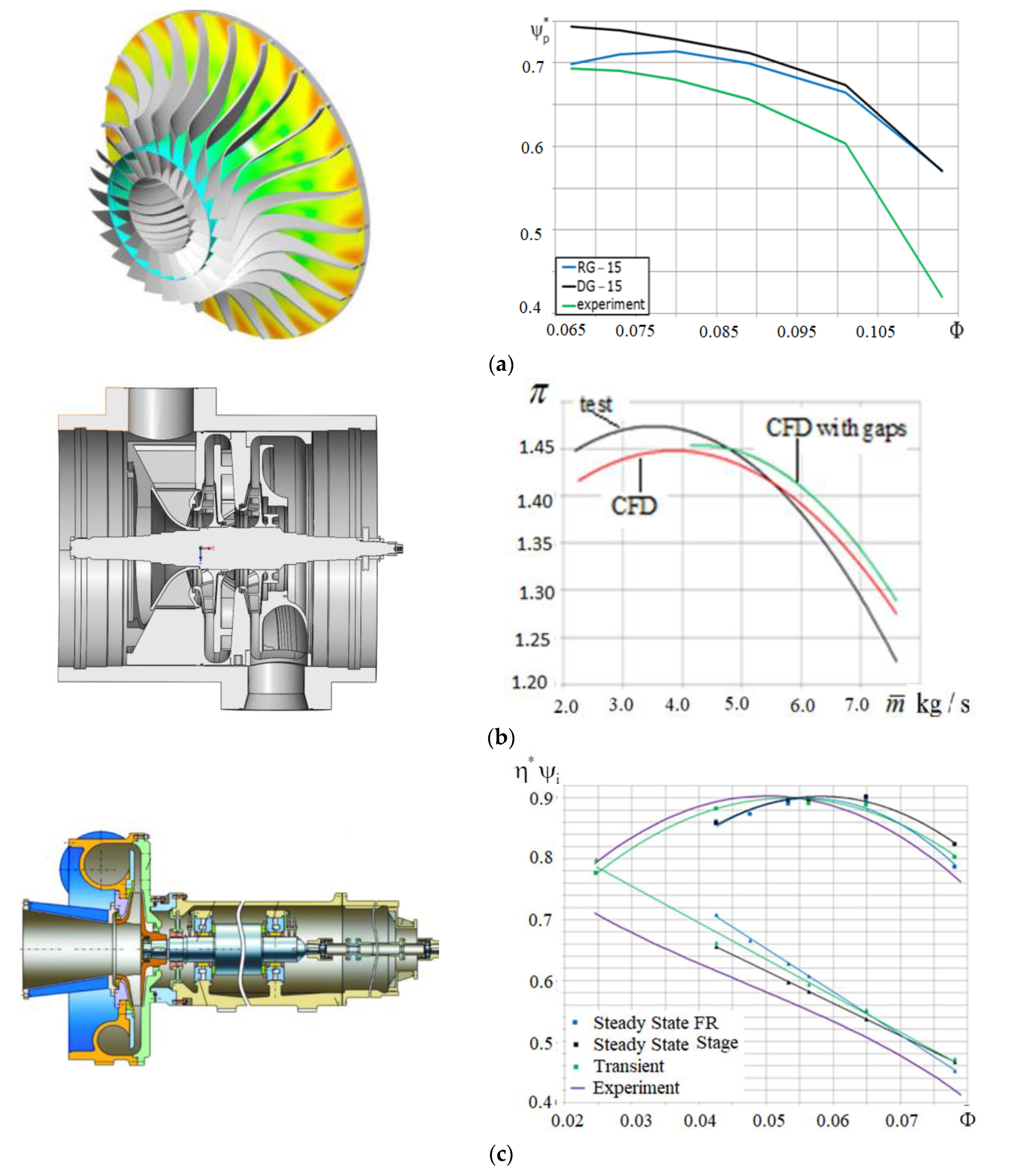




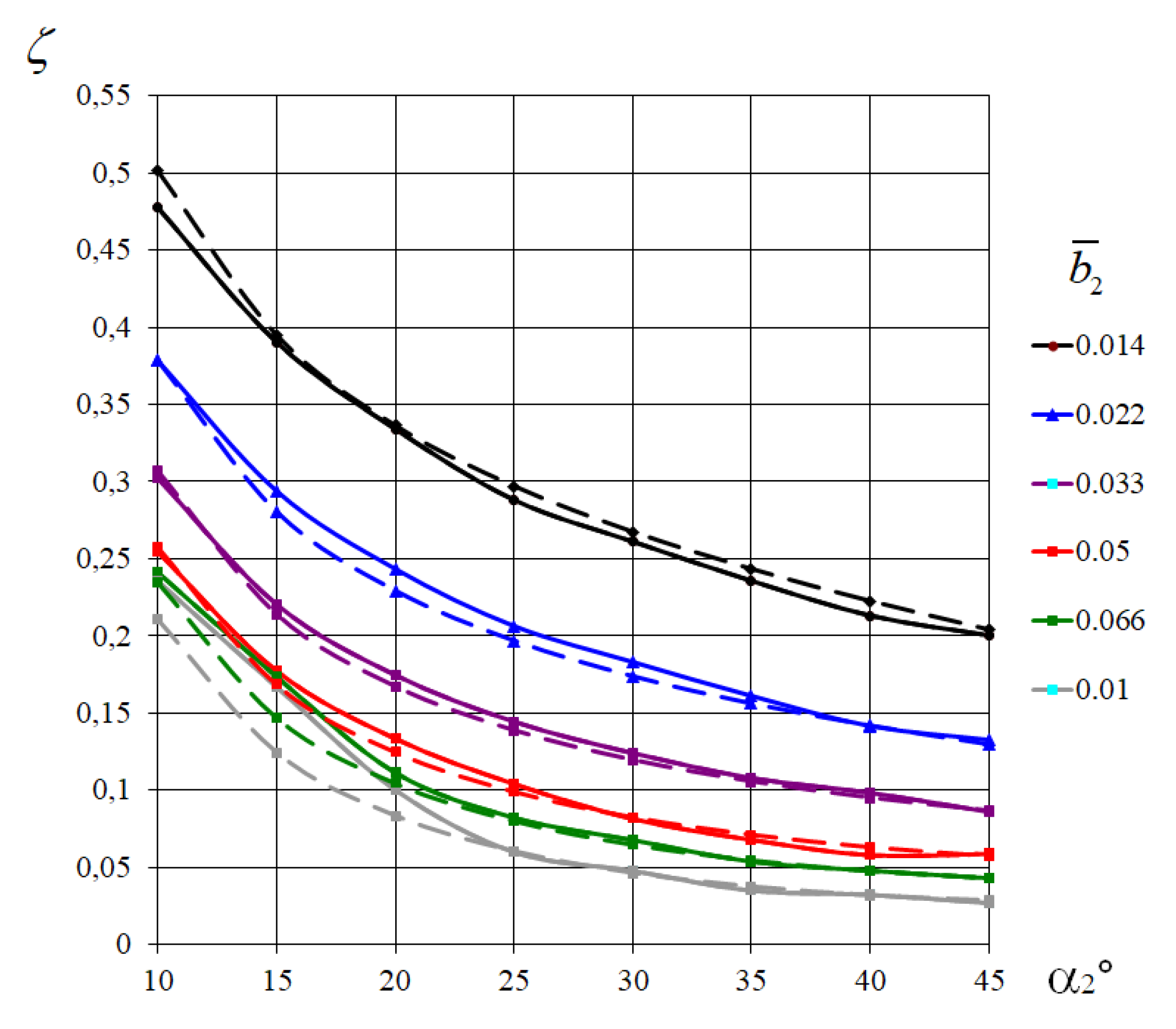



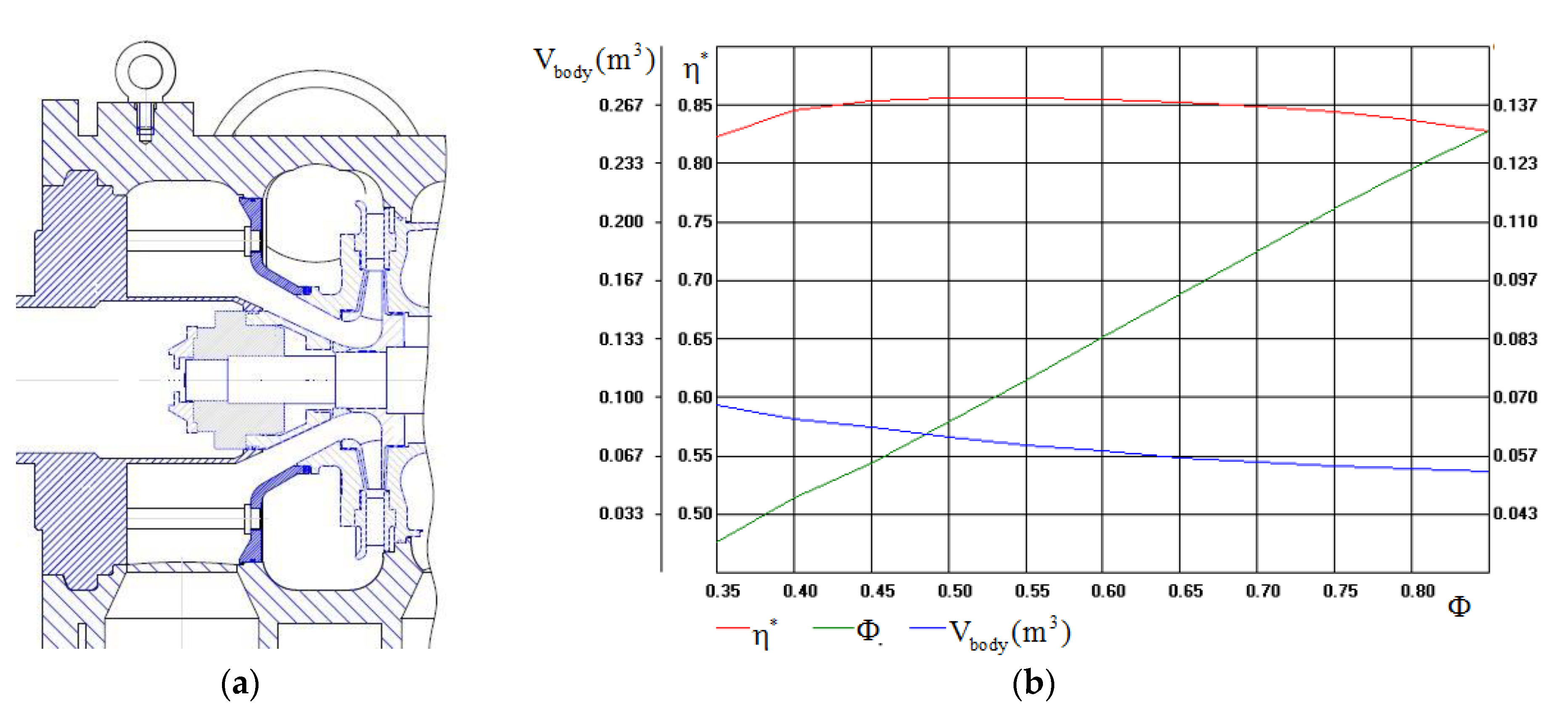

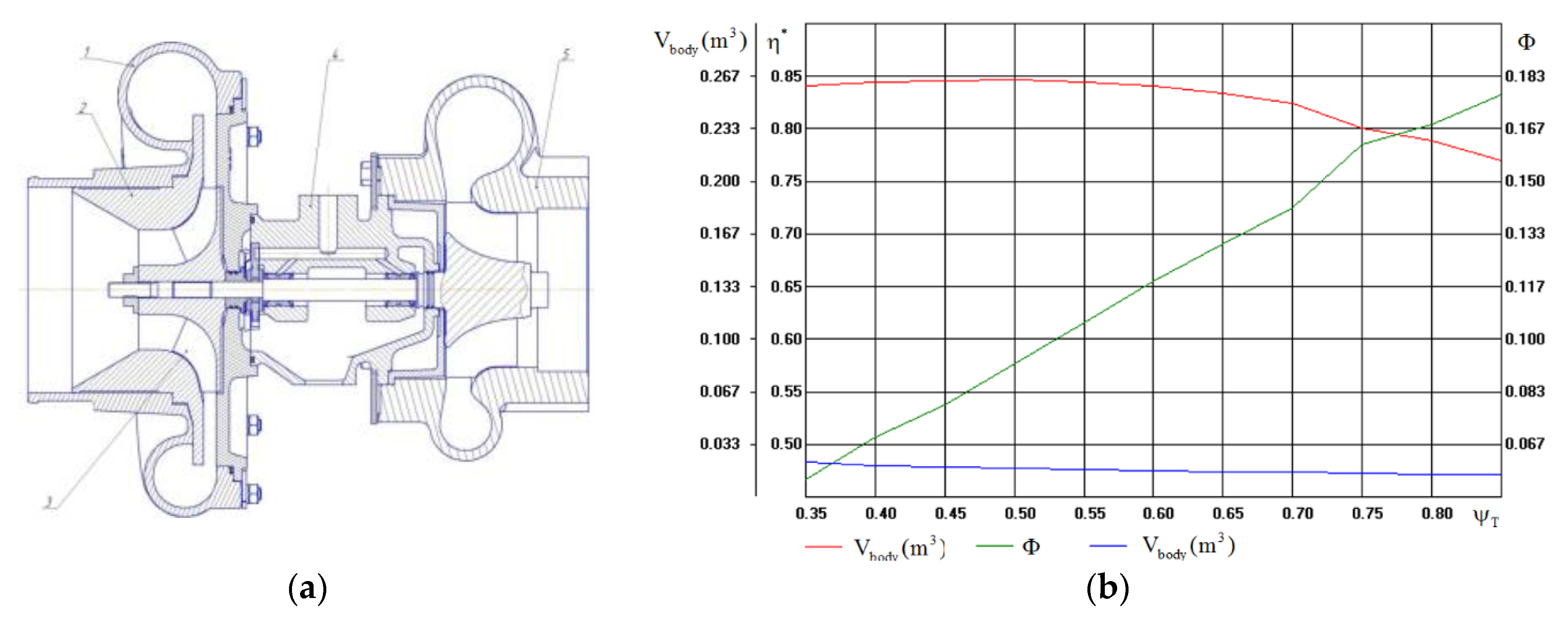
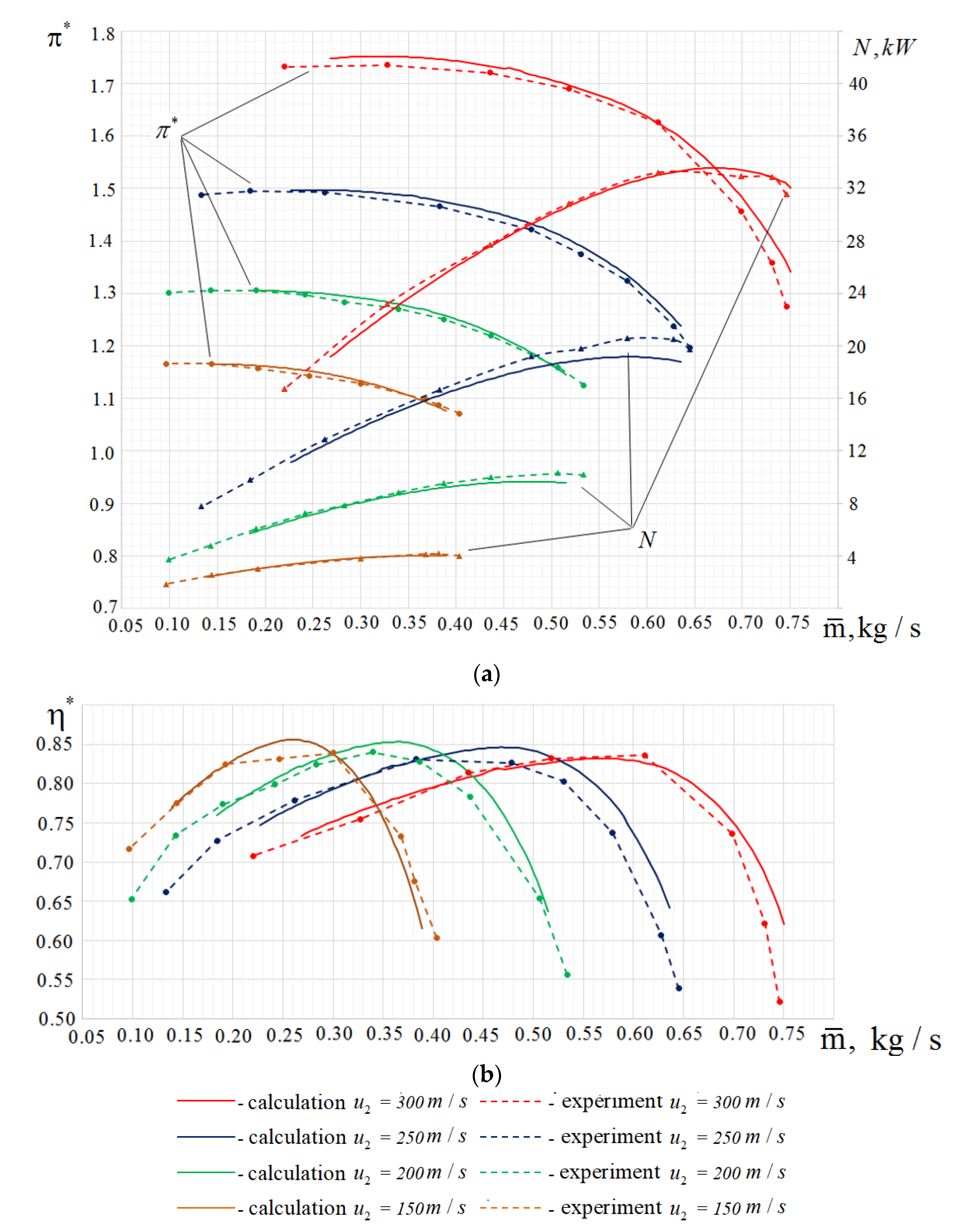
Publisher’s Note: MDPI stays neutral with regard to jurisdictional claims in published maps and institutional affiliations. |
© 2020 by the authors. Licensee MDPI, Basel, Switzerland. This article is an open access article distributed under the terms and conditions of the Creative Commons Attribution (CC BY) license (http://creativecommons.org/licenses/by/4.0/).
Share and Cite
Galerkin, Y.; Rekstin, A.; Soldatova, K.; Drozdov, A.; Solovyeva, O.; Semenovskiy, V.; Marenina, L. The Current State of the Engineering Method for the Optimal Gas-Dynamic Design and Calculation of Centrifugal Compressor. Energies 2020, 13, 5651. https://doi.org/10.3390/en13215651
Galerkin Y, Rekstin A, Soldatova K, Drozdov A, Solovyeva O, Semenovskiy V, Marenina L. The Current State of the Engineering Method for the Optimal Gas-Dynamic Design and Calculation of Centrifugal Compressor. Energies. 2020; 13(21):5651. https://doi.org/10.3390/en13215651
Chicago/Turabian StyleGalerkin, Yuri, Aleksey Rekstin, Kristina Soldatova, Aleksandr Drozdov, Olga Solovyeva, Vasiliy Semenovskiy, and Lyubov Marenina. 2020. "The Current State of the Engineering Method for the Optimal Gas-Dynamic Design and Calculation of Centrifugal Compressor" Energies 13, no. 21: 5651. https://doi.org/10.3390/en13215651







